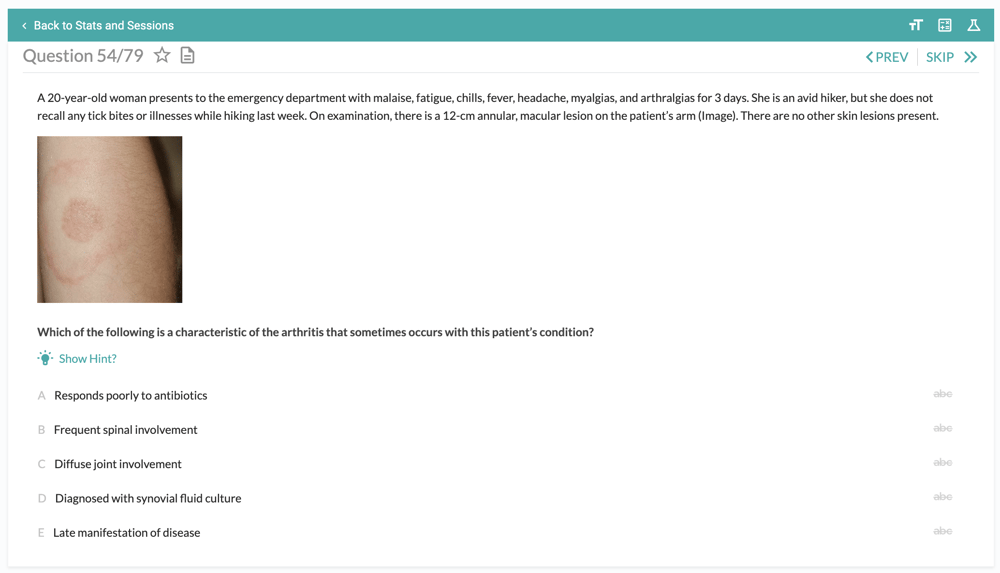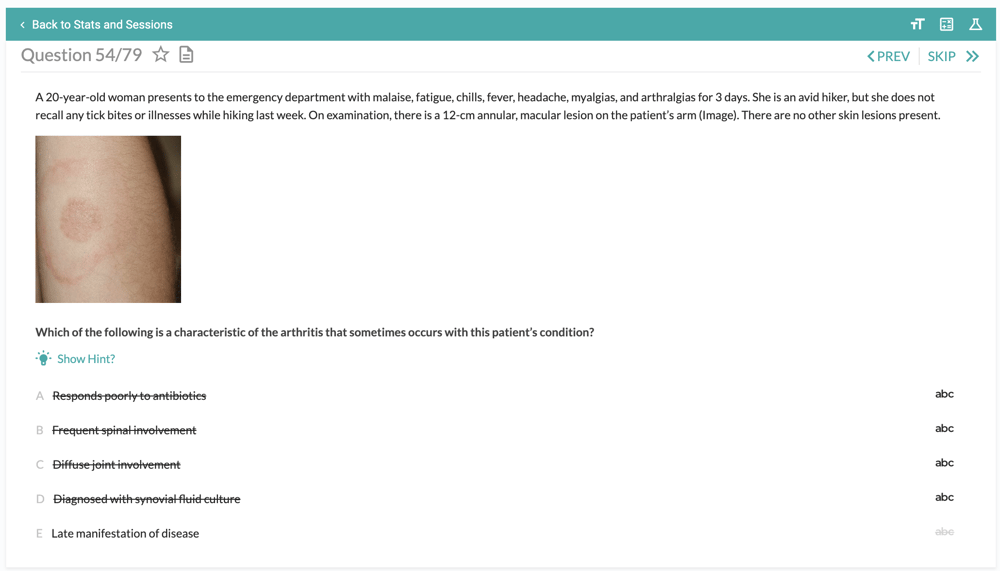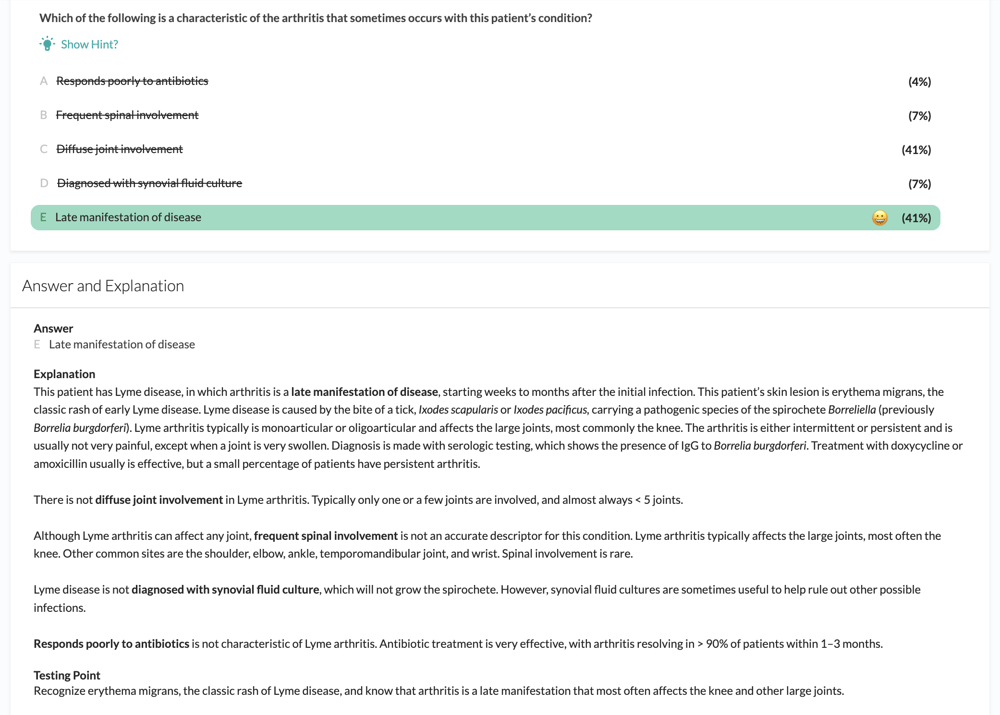
Key points:
1) The structure of a USMLE® question contains the stem of the question, a lead in, and answer options. Typically, USMLE questions provide five answer choices, but can have up to 11 answer choices.
2) Decode USMLE questions with these steps: Read the stem and lead-in, identify key information and anticipate an answer based on your knowledge, then, scrutinize answer choices, noting that one closely resembles the correct answer while others are feasible but incorrect. Utilize the elimination principle to narrow choices and confirm your selection.
3) Distractors are valuable tools for your exam preparation. They not only challenge your knowledge but also strengthen your understanding of various topics.
The United States Medical Licensing Examination (USMLE®) is a critical milestone for medical students! It's a multi-step exam series that tests your knowledge, skills, and ability to apply medical principles. The key format used in these exams is multiple-choice questions. In this blog, we'll break down the question format, explore how to analyze questions and answer options effectively, discuss the role of distractors, and highlight strategies for success, so keep reading!
The structure of USMLE® multiple-choice questions
USMLE® questions are carefully crafted to assess your understanding of medical concepts and your ability to make decisions in clinical settings. Let's dissect the structure of these questions:
-
The stem: This is the question itself, often presented as a clinical scenario or a straightforward question. The stem provides the context for the question and what is being asked.
-
The lead-in: The lead-in is the part of the stem that directly asks you to make a decision or select an answer.
-
Answer options: Typically, USMLE® questions provide five answer choices, but can have up to 11 answer choices. One is the correct answer (or the BEST answer), while the others are distractors (incorrect options). These distractors are carefully designed to challenge your knowledge and critical thinking abilities.
Here's an example of a question from the MedStudy Step 1 Qbank+ which closely mimics the format of the USMLE® questions. As you see, there is the question stem and image, the lead-in to the answer options, and the five answer options.

Screenshot of a question from MedStudy's Step 1 Qbank+
Want 78 other musculoskeletal system Q&As for free? 👀
Create your FREE account for unlimited access to the musculoskeletal system section for 30 days. Check out both the Step 1 & Step 2 Qbanks. No credit card required!
Decoding USMLE® questions: let's break it down
Understanding how to approach USMLE® questions can help you know what to look for on exam day! Here's a step-by-step:
1. Carefully read the stem and lead-in
Begin by reading the entire question stem and lead-in carefully. Ensure you understand the scenario presented and the specific query being asked. Sometimes, questions may try to trick you by including irrelevant details, so pay attention to the essential information.
2. Identify the key information
Look for critical pieces of information in the stem, such as symptoms, laboratory results, or diagnostic images. These details will guide you in selecting the correct answer.
3. Anticipate the answer
Before looking at the answer choices, try to formulate an answer based on your knowledge. This can help prevent bias when evaluating the answer options.
4. Examine each answer choice
Now, scrutinize each answer choice, starting with the one you initially formulated. Here's where the concept of "distractors" comes into play:
-
Distractor 1: easily confused with the correct answer: One distractor will closely resemble the correct answer but will have a subtle difference.
-
Other distractors: feasible but wrong answers: These distractors will seem plausible but ultimately incorrect. Use your knowledge to identify why they are wrong in the given context.
Note! Their might be more than one answer that seems like it could be the correct answer, "but there is only ONE BEST answer."
5. Apply the elimination principle
Utilize the process of elimination to narrow down your choices. Begin by eliminating the clearly incorrect options. Focus on the details that make each choice right or wrong in relation to the question.
6. Confirm your choice
Once you've narrowed down your options, revisit the stem and lead-in to ensure your choice aligns with the question's requirements. Whew! All this is within one question. We know it seems like a lot to do for each question. But, if you practice this answering strategy in your Qbanks while studying, it will come naturally (and quickly!) when you're in the exam.
Practice these 6 tips on the example question
Before you continue reading, take a second to practice these 6 tips to break down the question on this example question from the Step 1 Qbank+.
Carefully read the question step and lead-in, identify what you think the key info in the question is, anticipate an answer, and then examine each of the answer options before continuing. (We'll breakdown how to eliminate the distractors more below).
Note: if you ever need help identifying the key information while studying with your MedStudy Step 1 Qbank+, you can always select the hint feature.
In this question, the hint is "The circular, outwardly expanding rash on the patient's arm (i.e., erythema migrans) is pathognomonic for this condition.
 Screenshot of a question from MedStudy's Step 1 Qbank+
Screenshot of a question from MedStudy's Step 1 Qbank+
Why are distractors important?
As the StudyWise guide suggests*, distractors are valuable tools for your exam preparation. They not only challenge your knowledge but also strengthen your understanding of various topics. Here's why they are included:
-
To assess critical thinking: Distractors evaluate your ability to differentiate between closely related concepts, a vital skill for a practicing physician.
-
To reflect real-life decision-making: In clinical practice, you'll often face situations with multiple plausible but incorrect solutions. Distractors simulate this complexity.
-
To enhance learning: By analyzing distractors and imagining scenarios where they could be correct, you expand your knowledge base and make connections between different medical concepts.
In essence, mastering the art of handling distractors is essential to excel in USMLE® exams.
*Distractors are discussed in the IM and Peds version of the StudyWise guide, not in the student StudyWise
Let's bring back the example question from the MedStudy Step 1 Qbank+. After you have carefully read the stem and lead-in, identified the key information, anticipated the answer, examined each answer choice, you can now apply the elimination principle. As you can see, in the question below, we have eliminated the distractors with the strikethrough feature in the Qbank+.

Screenshot of a question from MedStudy's Step 1 Qbank+
Once you've eliminated the distractors, you can select your answer and read the explanation while in study mode. Of course, on the day of your USMLE® exam you won't see the answers right afterward, but you get the idea!
 Screenshot of a question from MedStudy's Step 1 Qbank+
Screenshot of a question from MedStudy's Step 1 Qbank+
USMLE® exams are not just about regurgitating facts; they demand a deep understanding of medical concepts and the ability to apply them in complex clinical scenarios. By dissecting questions, identifying key information, and skillfully handling distractors, you can navigate the USMLE® question format with confidence. Remember that practice and continuous learning are your best allies on this challenging journey to becoming a licensed medical professional.
Want 78 other musculoskeletal system Q&As for free? 👀
Create your FREE account for unlimited access to the musculoskeletal system section for 30 days. Check out both the Step 1 & Step 2 Qbanks. No credit card required!
Related content:


